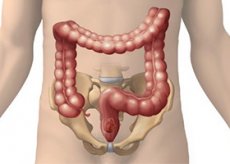Diseases of the rectum
Last reviewed: 23.04.2024

All iLive content is medically reviewed or fact checked to ensure as much factual accuracy as possible.
We have strict sourcing guidelines and only link to reputable media sites, academic research institutions and, whenever possible, medically peer reviewed studies. Note that the numbers in parentheses ([1], [2], etc.) are clickable links to these studies.
If you feel that any of our content is inaccurate, out-of-date, or otherwise questionable, please select it and press Ctrl + Enter.

Diseases of the rectum are characterized by typical symptoms, developing with the development of pathological processes in it and the anal canal. In the practice of a surgeon, rectal diseases are common, but the disease can be caused not only by rectal pathology, which is performed by surgeons and proctologists, but also by oncology, urological and gynecological pathology.
Rectal diseases are polymorphic, but the main symptoms are quite clear: pain in the anus, often radiating to the sacrum and coccyx, perineum, hip, to some extent the violation of the act of defecation and pain in it; itching; there may be discharge, bleeding.
How to recognize diseases of the rectum?
There are a lot of diagnostic methods, the prognologist performs a refined diagnosis, but the surgeon should direct to a narrow specialist of the fully examined patient. In most cases, there is no need for a proctologist, except for indications for surgical treatment. The main diagnostic method that will detect rectum diseases is rectal: examination, finger examination, anoskolia with the help of a rectal mirror, sigmoidoscopy, fibrocolonoscopy. It is obligatory to conduct the analysis of feces: a coproscopy, the analysis of a feces on eggs of worms, the latent blood, a dysbacteriosis, at presence of vydeleny - a cytology and the analysis of microflora. If there is a doubt about the primacy of the pathology or its connection with other pelvic organs, consultation of the gynecologist and urologist is necessary.
Rectal examination can reveal the functional state of the muscles of the anus, pathological changes in the tissues of the anal canal (cracks, fistulas, hemorrhoids, hypertrophy of the anal papillae, fibrotic polyps, benign and malignant tumors, posttraumatic cicatricial changes, foreign bodies, narrowing of the intestine), cystic and tumor- Inflammatory infiltrates in pararectal tissue, changes in the prostate gland and seminal vesicles in men (adenoma, cancer, prostatitis) and genitalia in women, peritoneum, Douglas-space.
The diagnostic procedure begins with an examination of the anus: the skin, the position of the anal opening (its displacement indicates the presence of rectum disease in pararectal tissue: paraproctitis, bumps, swelling, scarring in chronic proctitis), the inhibitory mechanism (at rest and during straining), the presence visible changes - malformations (prolapse, stenosis), traumatic injuries, cracks, hemorrhoids, fistulas, polyps, scar changes, hypertrophy of papillae, etc.
Finger research is carried out gradually in the patient's position on the side, on the back, and preferably in the knee-elbow position. First, examine the tone, elongation, elasticity of the external sphincter of the anus, the mucosa, the presence and the degree of soreness in the procedure. Then the finger is advanced into the ampoule itself, determining the state of its lumen (enlargement, narrowing, the presence of foreign bodies), gently palpating and assessing the walls (elastic and soft in norm, pastose, the presence of swelling, induration, scarring), prostate condition in men, rectum vaginal wall and cervix in women; determine the state of the pararectal tissue, the adjacent wall of the Douglas space, the inner surface of the sacrum and coccyx. After extraction of the finger, the glove is examined neither by the presence of secretions: usual caloric, altered feces, mucous, bloody, purulent, and chorious discharge. To study the upper rectal and pelvoreceptal cellulose, bimanual examination is used.
To detect diseases of the rectum and the pathology of the anal zone helps to conduct anoscopy with a rectal mirror. In-depth results are provided by a sigmoidoscopy and a colonoscopy (detection of cancer, polyposis, ulcerative colitis, examination of deep fistulas and other pathologies). For this purpose, the patient should be directed to a trained endoscopist (castor oil 30 g on the eve, enemas in the evening and in the morning to clean water) to an endoscopist.


 [
[